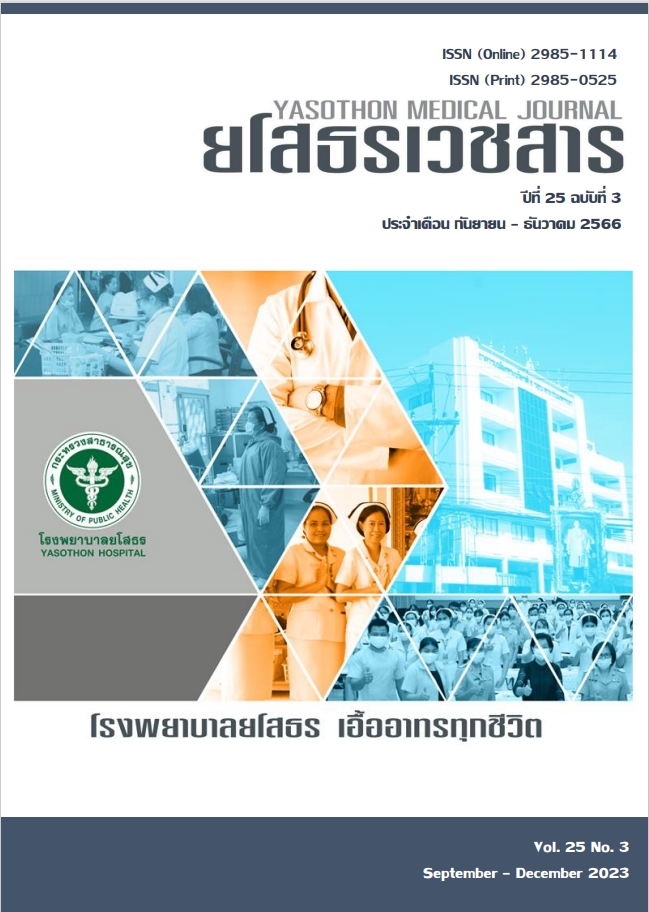ผลของการส่องกล้องตรวจลำไส้ใหญ่ และปัจจัยที่สัมพันธ์ต่อการเกิดมะเร็งลำไส้ใหญ่และไส้ตรง ในผู้ป่วยภายหลังที่ได้รับการคัดกรองมะเร็งลำไส้ใหญ่และไส้ตรง โดยคัดกรองด้วยวิธี FIT test ในโรงพยาบาลอำนาจเจริญ
คำสำคัญ:
อัตราการตรวจมะเร็งลำไส้ใหญ่และไส้ตรง, ปัจจัยเสี่ยง, FIT testบทคัดย่อ
วัตถุประสงค์ : เพื่อศึกษาอัตราการพบ และปัจจัยเสี่ยงที่สัมพันธ์กับการเกิดมะเร็งลำไส้ใหญ่และไส้ตรงในผู้ป่วยที่มีผล FIT test positive และได้รับการส่องกล้องตรวจลำไส้ใหญ่ในโรงพยาบาลอำนาจเจริญ
วิธีการศึกษา : เป็นการศึกษาเชิงวิเคราะห์ย้อนหลัง โดยศึกษาจากการทบทวน เวชระเบียนของผู้ป่วยในและผู้ป่วยนอกที่เข้ารับการตรวจคัดกรองมะเร็งลำไส้ใหญ่และไส้ตรงด้วยวิธีการตรวจ FIT test และมีผลเป็นบวก และได้รับการตรวจยืนยันโดยการส่องกล้องตรวจลำไส้ใหญ่ ในโรงพยาบาลอำนาจเจริญ ตั้งแต่วันที่ 1 ธันวาคม 2564 – 30 พฤศจิกายน 2565 ข้อมูลที่เก็บรวบรวม ได้แก่ ข้อมูลทั่วไปผู้ป่วย อายุ เพศ น้ำหนัก ส่วนสูง โรคประจำตัว อาการและอาการแสดง การดื่มสุรา การสูบบุหรี่ ประวัติโรคมะเร็งลำไส้ใหญ่และไส้ตรงในครอบครัว ค่าเลือด Hemoglobin, Carcinoembryonic antigen, ผลการส่องกล้องตรวจลำไส้ใหญ่ และ ผลจากการส่งพยาธิวิทยา นำมาวิเคราะห์ข้อมูล หาปัจจัยเสี่ยงที่สัมพันธ์กับการเกิดโรคมะเร็งลำไส้ใหญ่และไส้ตรง ด้วยสถิติ Chi-square test Binary Logistic regression analysis และ Multiple logistic regression นำเสนอโดยค่า Adjusted Odds ratio และ 95%CI
ผลการศึกษา : จากการศึกษาพบผู้ป่วยที่ได้รับการตรวจ FIT test และมีผลเป็นบวก และได้รับการตรวจยืนยันโดยการ ส่องกล้องตรวจลำไส้ใหญ่ตั้งแต่วันที่ 1 ธันวาคม 2564 – 30 พฤศจิกายน 2565 จำนวน 193 ราย ซึ่งผลจากการส่องกล้องตรวจลำไส้ใหญ่พบว่ามีผู้ป่วยที่มีติ่งเนื้อในลำไส้ใหญ่จำนวน 51 ราย (ร้อยละ 26.42) เมื่อทำการตรวจทางพยาธิวิทยาพบว่าเป็นติ่งเนื้อที่ไม่ใช่มะเร็ง 47 ราย (ร้อยละ 92.16) และติ่งเนื้อที่เป็นมะเร็ง 4 ราย (ร้อยละ 7.84) ซึ่งคิดเป็นมะเร็งร้อยละ 2.07 ของผู้ที่ได้รับการคัดกรอง FIT test positive ทั้งหมด ผลการวิเคราะห์ความสัมพันธ์ระหว่างลักษณะข้อมูล ของประชากรต่อปัจจัยเสี่ยงที่สัมพันธ์กับการเกิดมะเร็งลำไส้ใหญ่และไส้ตรง จากการส่องกล้องตรวจลำไส้ใหญ่ในผู้ป่วยที่ได้รับการตรวจคัดกรองด้วยวิธี Fit test ในโรงพยาบาลอำนาจเจริญ พบปัจจัยที่มีนัยสำคัญทางสถิติ ได้แก่ โรค ประจำตัวไขมันสูง (aOR 17.54 (0.98-312.70), 95% CI 2.06-120.52, p-value 0.001) และโรคประจำตัวไตวายเรื้อรัง (aOR 16.99 (1.01-286.41), 95% CI 1.26-85.87, p-value 0.01)
สรุป : อัตราการพบมะเร็งลำไส้ใหญ่และไส้ตรง ในผู้ป่วยที่มีผล FIT test positive และได้รับการส่องกล้องตรวจลำไส้ใหญ่ในโรงพยาบาลอำนาจเจริญ คือ ร้อยละ 2.07 และพบว่าปัจจัยเสี่ยงที่สัมพันธ์ต่อการเกิดโรคมะเร็งลำไส้ใหญ่และไส้ตรง ในผู้ป่วยที่มีผล FIT test positive และได้รับการส่องกล้องตรวจลำไส้ใหญ่ จากงานวิจัยชิ้นนี้พบว่ามีสองปัจจัยที่มีความเสี่ยงอย่างมีนัยสำคัญได้แก่ โรคไขมันในเลือดสูง และ โรคไตวายเรื้อรัง
เอกสารอ้างอิง
หน่วยงานเวชระเบียนและฐานข้อมูลโรคมะเร็ง สถาบันมะเร็งแห่งชาติ. ทะเบียนมะเร็งระดับโรงพยาบาล พ.ศ. 2563. กรุงเทพฯ: กลุ่มงานดิจิทัลการแพทย์; 2564.
Lieberman DA. Clinical practice. Screening for colorectal cancer. N Engl J Med 2009; 361(12): 1179–87. doi: 10.1056/NEJMcp0902176. PubMed PMID: 19759380.
Lin JS, Perdue LA, Henrikson NB, Bean SI, Blasi PR. Screening for Colorectal Cancer: Updated Evidence Report and Systematic Review for the US Preventive Services Task Force. JAMA 2021; 325(19): 1978-98. doi: 10.1001/jama.2021.4417. PubMed PMID: 34003220.
Johnson DA, Barkun AN, Cohen LB, Dominitz JA, Kaltenbach T, Martel M, et al. Optimizing adequacy of bowel cleansing for colonoscopy: recommendations from the US multisociety task force on colorectal cancer. Gastroenterology 2014; 147(4): 903-24. doi: 10.1053/j.gastro.2014.07.002. PubMed PMID: 25239068.
Riemann JF, Schröder C, Kallenbach M, Giersiepen K, Schmoll HJ. Benefits and Risks of Colorectal Cancer Screening. Oncol Res Treat 2014; 37 Suppl 3, 11–20. doi: 10.1159/000364886. PubMed PMID: 25195828.
Wolf AMD, Fontham ETH, Church TR, Flowers CR, Guerra CE, LaMonte SJ, et al. Colorectal Cancer Screening for Average-Risk Adults: 2018 Guideline Update From the American Cancer Society. CA Cancer J Clin 2018; 68(4): 250–81. doi: 10.3322/caac.21457. PubMed PMID: 29846947.
Levin TR, Corley DA, Jensen CD, Schottinger JE, Quinn VP, Zauber AG, et al. Effects of Organized Colorectal Cancer Screening on Cancer Incidence and Mortality in a Large Community-Based Population. Gastroenterology 2018; 155(5): 1383–91. doi: 10.1053/j.gastro.2018.07.017. PubMed PMID: 30031768.
Elfant AB. Hot Topics in Primary Care: Colorectal Cancer Screening. J Fam Pract 2015; 64(12 Suppl):S10–5. PubMed PMID: 26845007.
Levin B, Lieberman DA, McFarland B, Smith RA, Brooks D, Andrews KS, et al. Screening and surveillance for early detection of colorectal cancer and adenomatous polyps, 2008: a joint guideline from the American Cancer Society, the US MultiSociety Task Force on Colorectal Cancer, and the American College of Radiology. CA Cancer J Clin 2008; 58(3): 130-60. doi: 10.3322/CA.2007.0018. PubMed PMID: 18322143.
U.S. Preventive Services Task Force. Screening for colorectal cancer: U.S. Preventive Services Task Force recommendation statement. Ann Intern Med 2008; 149(9): 62737. doi: 10.7326/0003-4819-149-9-200811040-00243. PubMed PMID: 18838716.
Whitlock EP, Lin JS, Liles E, Beil TL, Fu R. Screening for colorectal cancer: a targeted, updated systematic review for the U.S. Preventive Services Task Force. Ann Intern Med 2008; 149(9): 63858. doi: 10.7326/0003-4819-149-9-200811040-00245. PubMed PMID: 18838718.
Hannan LM, Jacobs EJ, Thun MJ. The association between cigarette smoking and risk of colorectal cancer in a large prospective cohort from the United States. Cancer Epidemiol Biomarkers Prev 2009; 18(12): 3362-7. doi: 10.1158/1055-9965.EPI-09-0661. PubMed PMID: 19959683.
LoConte NK, Brewster AM, Kaur JS, Merrill JK, Alberg AJ. Alcohol and cancer: A statement of the American Society of Clinical Oncology. J Clin Oncol 2018; 36(1): 83-93. doi: 10.1200/JCO.2017.76.1155. PubMed PMID: 29112463.
Hewitson P, Glasziou P, Irwig L, Towler B, Watson E. Screening for colorectal cancer using the faecal occult blood test, Hemoccult. Cochrane Database Syst Rev 2007; 2007(1): CD001216. doi: 10.1002/14651858.
CD001216.pub2. PubMed PMID: 17253456.
Reumkens A, Rondagh EJ, Bakker CM, Winkens B, Masclee AA, Sanduleanu S. Post-colonoscopy complications: A systematic review, time trends, and meta-analysis of population based studies. Am J Gastroenterol 2016; 111(8): 1092–101. doi: 10.1038/ajg.2016.234. PubMed PMID: 27296945.
Pickhardt PJ, Hasan C, Halligan S, Marmo R. Colorectal cancer: CT colonography and colonoscopy for detection--systematic review and meta-analysis. Radiology 2011: 259(2): 393-405.
doi: 10.1148/radiol.11101887. PubMed PMID: 21415247.
Smith A, Young GP, Cole SR, Bampton P. Comparison of a brush sampling fecal immunochemical test for hemoglobin with a sensitive guaiac-based fecal occult blood test in detection of colorectal neoplasia. Cancer 2006; 107(9): 2152-9. doi: 10.1002/cncr.22230. PubMed PMID: 16998938.
World Cancer Research Fund/American Institute for Cancer Research. Diet, Nutrition, Physical Activity and Cancer: a global perspective. Continuous Update Project Expert Report 2018; 2018.
Kohler LN, Harris RB, Oren E, Roe DJ, Lance P, Jacobs ET. Adherence to nutrition and physical activity cancer prevention guidelines and development of colorectal adenoma. Nutrients 2018; 10(8): 1098.
doi: 10.3390/nu10081098. PubMed PMID: 30115827.
Wu MY, Chang TC, Chao TY, Huang MT, Lin HW. Risk of colorectal cancer in chronic kidney disease: a matched cohort study based on administrative data. Ann Surg Oncol 2013; 20(12): 3885-91.
doi: 10.1245/s10434-013-3065-8. PubMed PMID: 23807660.
เผยแพร่แล้ว
เวอร์ชัน
- 2025-08-08 (2)
- 2023-12-22 (1)
รูปแบบการอ้างอิง
ฉบับ
ประเภทบทความ
สัญญาอนุญาต
ลิขสิทธิ์ (c) 2023 ยโสธรเวชสาร

อนุญาตภายใต้เงื่อนไข Creative Commons Attribution-NonCommercial-NoDerivatives 4.0 International License.
บทความที่ได้รับการตีพิมพ์เป็นลิขสิทธิ์ของยโสธรเวชสาร







